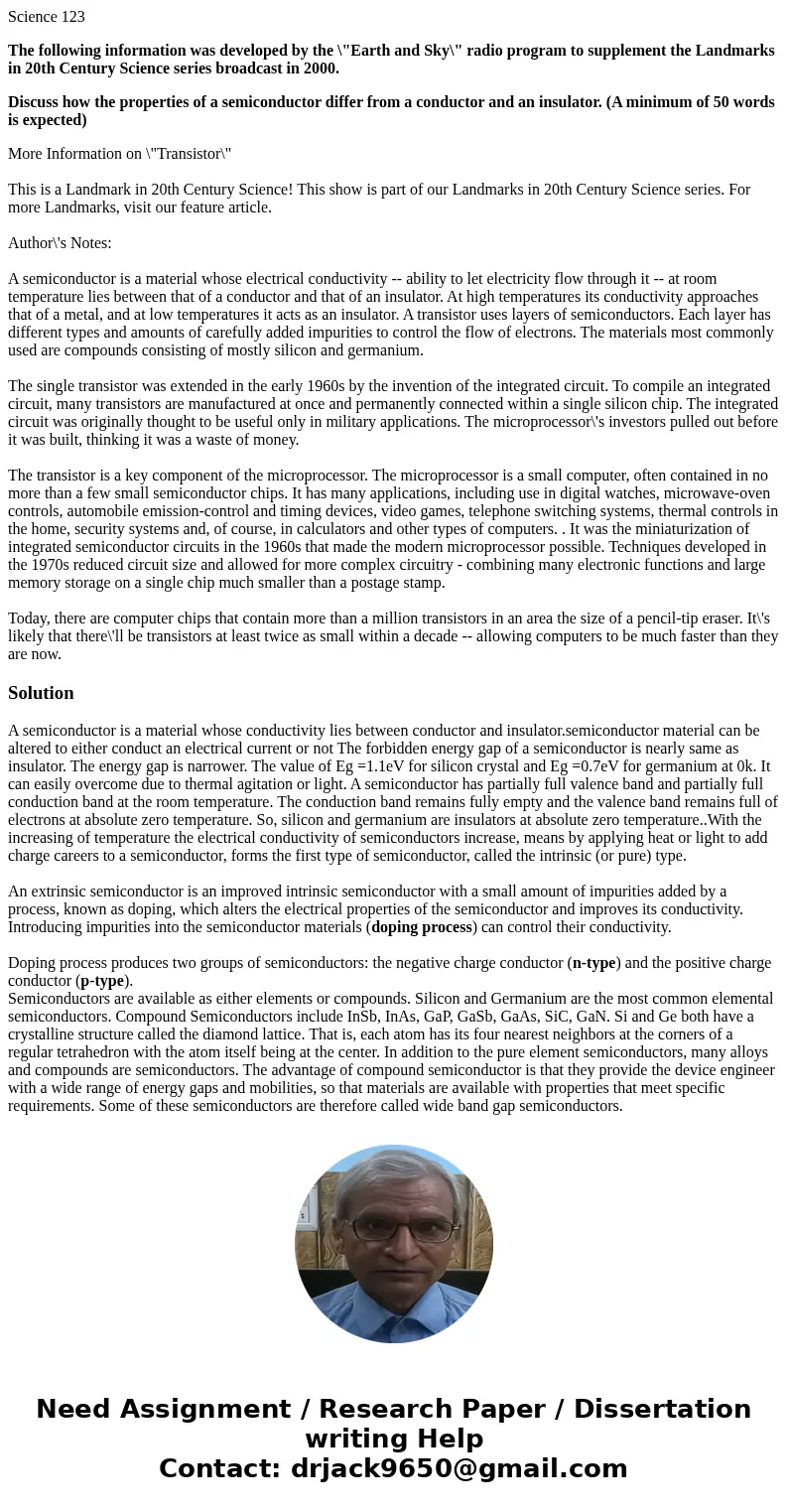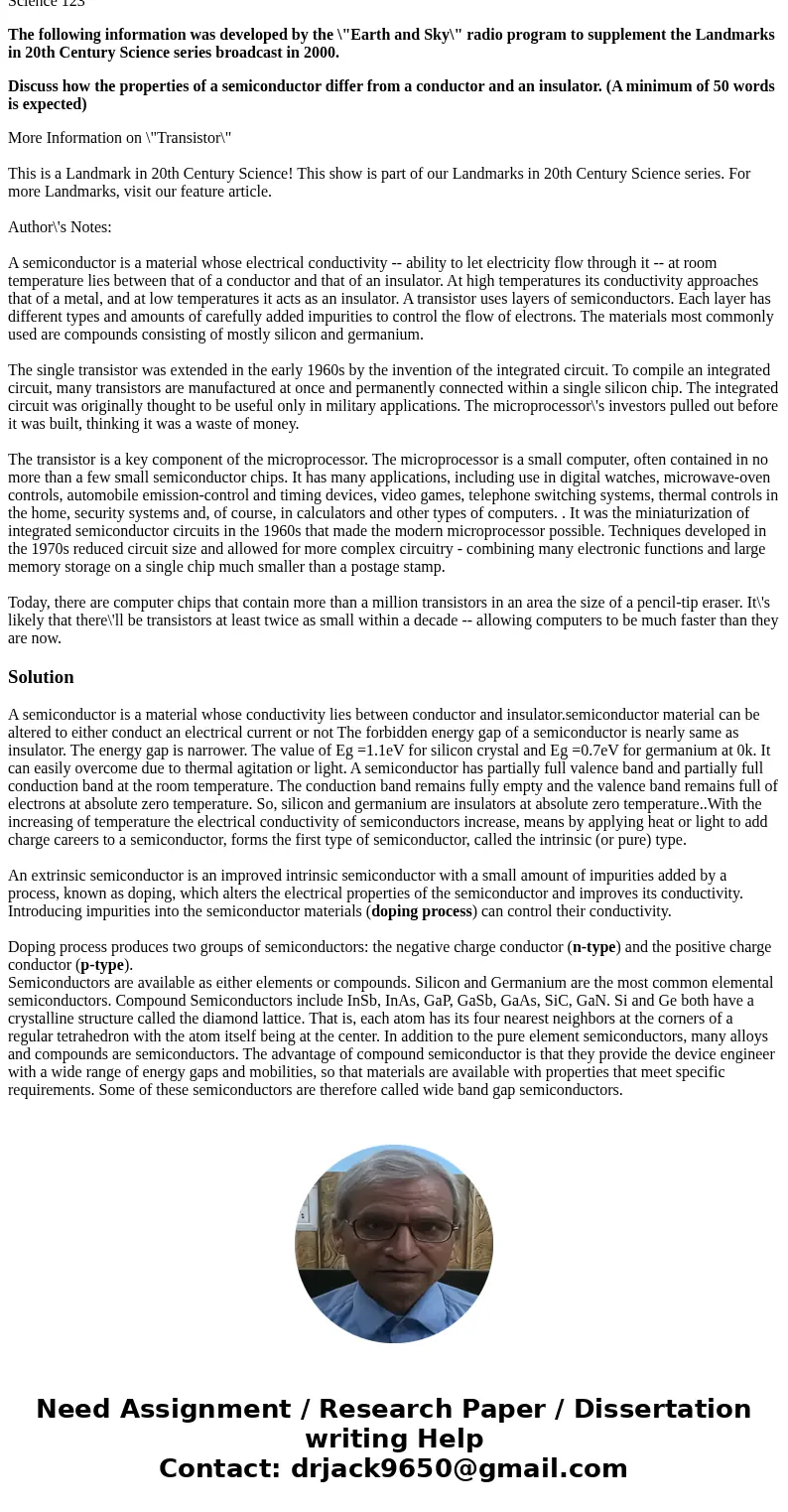Science 123 The following information was developed by the E
Science 123
The following information was developed by the \"Earth and Sky\" radio program to supplement the Landmarks in 20th Century Science series broadcast in 2000.
Discuss how the properties of a semiconductor differ from a conductor and an insulator. (A minimum of 50 words is expected)
More Information on \"Transistor\"
This is a Landmark in 20th Century Science! This show is part of our Landmarks in 20th Century Science series. For more Landmarks, visit our feature article.
Author\'s Notes:
A semiconductor is a material whose electrical conductivity -- ability to let electricity flow through it -- at room temperature lies between that of a conductor and that of an insulator. At high temperatures its conductivity approaches that of a metal, and at low temperatures it acts as an insulator. A transistor uses layers of semiconductors. Each layer has different types and amounts of carefully added impurities to control the flow of electrons. The materials most commonly used are compounds consisting of mostly silicon and germanium.
The single transistor was extended in the early 1960s by the invention of the integrated circuit. To compile an integrated circuit, many transistors are manufactured at once and permanently connected within a single silicon chip. The integrated circuit was originally thought to be useful only in military applications. The microprocessor\'s investors pulled out before it was built, thinking it was a waste of money.
The transistor is a key component of the microprocessor. The microprocessor is a small computer, often contained in no more than a few small semiconductor chips. It has many applications, including use in digital watches, microwave-oven controls, automobile emission-control and timing devices, video games, telephone switching systems, thermal controls in the home, security systems and, of course, in calculators and other types of computers. . It was the miniaturization of integrated semiconductor circuits in the 1960s that made the modern microprocessor possible. Techniques developed in the 1970s reduced circuit size and allowed for more complex circuitry - combining many electronic functions and large memory storage on a single chip much smaller than a postage stamp.
Today, there are computer chips that contain more than a million transistors in an area the size of a pencil-tip eraser. It\'s likely that there\'ll be transistors at least twice as small within a decade -- allowing computers to be much faster than they are now.
Solution
A semiconductor is a material whose conductivity lies between conductor and insulator.semiconductor material can be altered to either conduct an electrical current or not The forbidden energy gap of a semiconductor is nearly same as insulator. The energy gap is narrower. The value of Eg =1.1eV for silicon crystal and Eg =0.7eV for germanium at 0k. It can easily overcome due to thermal agitation or light. A semiconductor has partially full valence band and partially full conduction band at the room temperature. The conduction band remains fully empty and the valence band remains full of electrons at absolute zero temperature. So, silicon and germanium are insulators at absolute zero temperature..With the increasing of temperature the electrical conductivity of semiconductors increase, means by applying heat or light to add charge careers to a semiconductor, forms the first type of semiconductor, called the intrinsic (or pure) type.
An extrinsic semiconductor is an improved intrinsic semiconductor with a small amount of impurities added by a process, known as doping, which alters the electrical properties of the semiconductor and improves its conductivity. Introducing impurities into the semiconductor materials (doping process) can control their conductivity.
Doping process produces two groups of semiconductors: the negative charge conductor (n-type) and the positive charge conductor (p-type).
Semiconductors are available as either elements or compounds. Silicon and Germanium are the most common elemental semiconductors. Compound Semiconductors include InSb, InAs, GaP, GaSb, GaAs, SiC, GaN. Si and Ge both have a crystalline structure called the diamond lattice. That is, each atom has its four nearest neighbors at the corners of a regular tetrahedron with the atom itself being at the center. In addition to the pure element semiconductors, many alloys and compounds are semiconductors. The advantage of compound semiconductor is that they provide the device engineer with a wide range of energy gaps and mobilities, so that materials are available with properties that meet specific requirements. Some of these semiconductors are therefore called wide band gap semiconductors.


 Homework Sourse
Homework Sourse